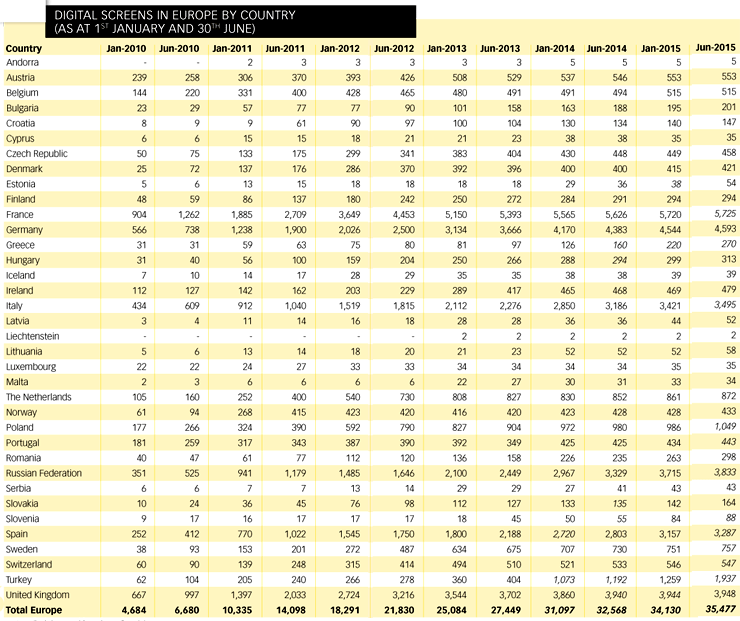
Reg. Trib. Milano n. 418 del 02.07.2007
- Direttore responsabile: Elisabetta Brunella
 |
 |
International Edition No. 125 - year 11 - 11 February 2016
Special issue on the occasion of the 66th Berlin International Film Festival
more than 15,000 subscribers |
In 2015 audiences increase (+5.6%) in Europe's cinemas,
while digitization reaches 95% of screens *
"2015 was a good year for Europe's movie theatres, indeed an excellent one. In fact the rise in admissions and box office regards practically all the countries analysed by MEDIA Salles, unlike those years - such as 2014 - in which a result that was positive for Europe as a whole concealed marked differences, with some countries growing and others in decline, even to a considerable extent," commented Paolo Protti, President of MEDIA Salles.
The 19 countries in Western Europe - with a total of 895.2 million admissions compared to 837.5 in 2014 - record a growth of 6.9%, whilst the 17 in Central and Eastern Europe and the Mediterranean Rim close the year with a 2.3% increase and a total of 356.1 million tickets sold, as against 348.0 million in 2014. For this part of Europe it is the tenth consecutive increase, making it possible to more or less double audiences in the space of a decade.
Western Europe
Exceptional increases in ticket sales have been recorded in Portugal (20.4%) and Finland (19.6%).
The main reason for Finland's exceptional increase in audiences comes thanks to the excellent results not only of Hollywood movies but also of Finnish titles. The latter sold 2.6 million tickets (29.8% of the total), even bettering the 2012 record (2.4 million tickets) and thus obtaining the best result since 1970.
On the top 5 markets, too, a particularly flattering increase is recorded: this comes from Germany where, according to data published by the FFA, audiences reached 139.2 million, growing by 14.3% compared to 2014. With this leap forward Germany returns to a level the country had failed to recover since 2009.
Growth in the United Kingdom (9.2%) is also above average. One of the reasons for this result (over 14 million more spectators compared to the previous year) is the success of "homemade" films, including Second Best Exotic Marigold Hotel (Marigold Hotel 2), Suffragette, Spectre - the latest 007 - and The Lady in the Van. And although Star Wars was not officially a British-nationality film, its "British" side (it was shot in the legendary Pinewood Studios, like the 007 series) resulted in "the force being in the number of tickets sold in the United Kingdom", as Mike Vickers, one of the most prominent independent programmers in the country, wished to emphasize.
In Italy, an 8.9% rise in admissions is recorded with a total ticket sales of 105.2 million for screens running at least 60 days a year.
Spain, which grows by 7.5%, i.e. more than the European average, gains the second increase after a negative run beginning in 2005.
Of the 5 leading markets in Western Europe, France reveals a contrary trend, losing 1.8% of audiences, yet still confirming the country as Europe's leading market, maintaining figures well over the 200 million threshold.
Positive signs also come from Luxembourg (+15%), Denmark (+12.6%), Switzerland (+11.3%), Austria (+10.5%), Greece (+9.3%) and Norway (+8.6%), all countries growing more than the average rate for Western Europe. Perfectly in line with this average is the Netherlands, touching on 33 million spectators.
Less evident growth is recorded in Ireland (+5.6%), Sweden (+4.7%), Iceland (+2.8%) and Belgium (+1.2%).
Central and Eastern Europe and the Mediterranean Rim
In Central and Eastern Europe and the Mediterranean Rim, where the situation is generally positive, slight dips are to be seen on the two largest markets: Russia (-0.2%) and Turkey (-1.5%). The latter are nonetheless countries that have seen the highest growth in audiences on the whole continent over the past few years. Indeed, despite the dip in admissions, the box office recorded both for Russia and for Turkey - if calculated in local currency - proves to have grown by respectively 1.9% and 4%.
In terms of admissions, exceptional figures are recorded in Estonia (+19.0%) and Hungary (+18.4%). In the latter country the 2015 success was due to films “made in Hungary”, thanks in particular to the movie Saul Fia (Son of Saul) which, after the award obtained at Cannes and nomination for an Oscar, established itself mainly in art-house circles.
Above-average growth is also recorded in the Czech Republic (+12.1%), Slovakia (+11.8%), Poland (+10.7%), Romania (+9.8%), Slovenia (+8.9%), Bulgaria (+8.6%), Malta (+7.8%), Croatia (+6.6%) and Cyprus (+5.9%).
Increases in Lithuania (+3.0%) and Latvia (+2.0%) were more modest.
Digitization nears completion: the data at 1st January 2016
During 2015 the number of digital screens continued to grow: Europe started 2016 with 36,538 digital projectors, around 95% of the total, with a 7% increase compared to 1st January 2015.
Over the 12 months of 2015, in some of the few countries that have still not digitized all their screens, the rate of conversion to the new technologies speeded up considerably. This is the case for a large market like Turkey, where a rate of digitization of 55% rose to over 80%, with particularly significant growth in the first six months of 2015. A similar rise is also to be seen on a smaller market like Latvia, growing from 69% to over 90%. Estonia, too, has recorded considerable growth: digital screens, which at the start of 2015 represented 49%, had increased to 70% a year later. Greece now stands at the same level with a market where, at the beginning of 2015, digital projectors were installed on 46% of screens.
On the continent's six leading markets, Russia (approx. 99.9%), closely followed by Italy (approx. 97%) and Spain (approx. 92%), is now practically in line with France, the United Kingdom and Germany, which had already achieved more or less complete digitization.
To sum up, with its 36,538 digital screens, Europe stands as the world's third largest market after North America, with around 43,000 digital projectors, and Asia and the Pacific area, which sprang into the lead during 2015, with over 46,000 units.
* This is an updated version (09 February 2017) of the text published on the occasion of the 66th Berlinale.
Click here to see the tables published in the European Cinema Yearbook - 2016 edition
|
||||||||||||
|





